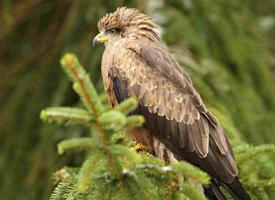
Veszélyeztetettség
| Veszélyeztetett |
Állatleírás
The Eastern Imperial Eagle (Aquila heliaca) is a large and powerful bird of prey that belongs to the family Accipitridae, which encompasses hawks, eagles, and kites among others. This majestic raptor is known for its impressive size, distinctive plumage, and regal bearing, making it one of the most revered birds in its range. The species primarily inhabits open and semi-open landscapes, including forests with clearings, steppe grasslands, and agricultural areas, stretching from Southeastern Europe across the Middle East to Central Asia.Adult Eastern Imperial Eagles are notable for their considerable size, with a body length ranging from 70 to 90 centimeters (28 to 35 inches), and a wingspan that can reach up to 2 meters (6.5 feet). They exhibit sexual dimorphism, though it is mainly in size, with females being slightly larger than males. The plumage of adults is predominantly dark brown, with a lighter golden-brown nape and crown, giving the eagle a distinguished appearance. The shoulders may display a slightly paler brown, and the tail is often barred with darker streaks. Juveniles and immature eagles, however, have a more mottled appearance with varying shades of brown and may have white on their underparts and under their wings.
Eastern Imperial Eagles possess a formidable beak and large, powerful talons, reflective of their predatory lifestyle. Their diet mainly consists of medium-sized mammals, such as hares and ground squirrels, although they are also known to prey on other birds, reptiles, and occasionally carrion. These eagles are skilled hunters, often utilizing their acute vision to spot prey from a distance before swooping down to capture it with their talons.
Breeding typically occurs once a year, with the mating pair engaging in spectacular aerial displays as part of their courtship rituals. The nests are large structures built with sticks and are usually located in tall trees, although they may also nest on cliffs in areas where trees are scarce. A typical clutch consists of 2 to 3 eggs, which are primarily incubated by the female while the male provides food. The chicks are altricial, meaning they are born relatively undeveloped and require considerable parental care before they can fend for themselves.
The Eastern Imperial Eagle is a migratory species, with many birds traveling from their breeding grounds to warmer regions in South Asia and Africa to spend the winter. This long-distance migration showcases their remarkable endurance and navigational skills.
Despite its strength and adaptability, the Eastern Imperial Eagle faces several threats, including habitat destruction, human-induced disturbances, and direct persecution. Additionally, the use of pesticides and rodenticides can reduce their prey base or poison the eagles directly. As a result, the species is classified as Vulnerable by the International Union for Conservation of Nature (IUCN), emphasizing the need for ongoing conservation efforts to ensure the survival of this magnificent raptor.
Conservation initiatives aimed at protecting the Eastern Imperial Eagle include habitat preservation, anti-poaching measures, and public awareness campaigns to reduce human-eagle conflicts. These efforts, combined with international cooperation, are critical to securing a future for the Eastern Imperial Eagle in its natural habitats across Eurasia.
Előfordulási térkép

Hasonló állatok
Új állatfotók
Top 10 állat
- Dolphin gull (Leucophaeus scoresbii)
- Diana monkey (Cercopithecus diana)
- Moustached guenon (Cercopithecus cephus)
- Galápagos tortoise (Geochelone nigra complex)
- Japanese macaque (Macaca fuscata)
- Stone loach (Barbatula barbatula)
- Russian tortoise (Testudo horsfieldii)
- Greek tortoise (Testudo graeca)
- Common flying dragon (Draco volans)
- Vendace (Coregonus albula)


